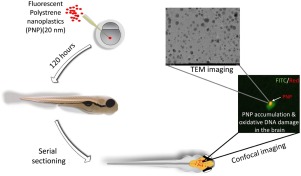当前位置:
X-MOL 学术
›
Neurotoxicology
›
论文详情
Our official English website, www.x-mol.net, welcomes your feedback! (Note: you will need to create a separate account there.)
Polystyrene nanoplastics (20 nm) are able to bioaccumulate and cause oxidative DNA damages in the brain tissue of zebrafish embryo (Danio rerio).
NeuroToxicology ( IF 3.4 ) Pub Date : 2019-12-17 , DOI: 10.1016/j.neuro.2019.12.010 Teoman Özgür Sökmen 1 , Ekrem Sulukan 2 , Medine Türkoğlu 3 , Alper Baran 4 , Mustafa Özkaraca 5 , Saltuk Buğrahan Ceyhun 2
NeuroToxicology ( IF 3.4 ) Pub Date : 2019-12-17 , DOI: 10.1016/j.neuro.2019.12.010 Teoman Özgür Sökmen 1 , Ekrem Sulukan 2 , Medine Türkoğlu 3 , Alper Baran 4 , Mustafa Özkaraca 5 , Saltuk Buğrahan Ceyhun 2
Affiliation

|
Nano-sized plastic particles formed from both daily use plastics and its debris have become a potential health and environmental problem due to features such as transportation through food webs and maternal transfer. Although many studies on the toxicity of plastics exist more detailed and molecular studies are needed to evaluate and review the effects of plastics especially in nano-size range. For this purpose, we have microinjected polystyrene nanoplastics (PNP) (20 nm) to the zebrafish embryo, which is one of the best model organisms for developmental toxicity studies, to simulate intake with food or maternal. Survival, hatching and malformations evaluated during the experimental period (120 h). Moreover, we have aimed to put forth the presence of reactive oxygen species (ROS) and apoptosis signalling accumulation in the body in addition to bioaccumulation of PNP and immunochemical toxicity (8-OHdG) on the brain of zebrafish larvae at the 120th hour. According to results, it has been demonstrated that 20 nm diameter PNP can reach the brain and bioaccumulate there, moreover lead to oxidative DNA damage in the brain regions where it bioaccumulates. Here we have also imaged the PNP from a vertebrate brain via transmission electron microscopy (TEM) for the first time. As a result of these, it has been detected increasing mortality and prevailing abnormalities in addition to excessive ROS and apoptosis in especially the brain. As a conclusion, obtained data have suggested that precautions, on the use and contamination of the plastic product, to be taken during both pregnancy and baby care/feeding are important for the health of the baby in future.
中文翻译:

聚苯乙烯纳米塑料(20 nm)能够在斑马鱼胚胎(Danio rerio)的脑组织中生物积累并引起DNA氧化损伤。
由日常使用的塑料及其碎屑形成的纳米级塑料颗粒由于诸如通过食物网的运输和母体转移等特征而成为潜在的健康和环境问题。尽管存在许多关于塑料毒性的研究,但更详细的研究需要分子研究来评估和审查塑料的效果,尤其是在纳米尺寸范围内。为此,我们向斑马鱼胚胎显微注射了聚苯乙烯纳米塑料(PNP)(20 nm),该斑马鱼胚胎是进行发育毒性研究的最佳模式生物之一,可以模拟食物或母体的摄入。在实验期间(120小时)评估生存率,孵化率和畸形。而且,我们的目标是在第120小时时,除了斑马鱼幼虫的大脑中PNP的生物蓄积和免疫化学毒性(8-OHdG)之外,还提出体内活性氧(ROS)和细胞凋亡信号传导的积累。根据结果,已证明直径为20 nm的PNP可以到达大脑并在那里生物蓄积,而且会导致其生物蓄积的大脑区域发生氧化DNA损伤。在这里,我们还首次通过透射电子显微镜(TEM)对来自脊椎动物大脑的PNP进行了成像。结果,除了特别是大脑中过量的ROS和细胞凋亡外,已经发现死亡率增加和普遍异常。总之,获得的数据表明,关于塑料产品的使用和污染的预防措施,
更新日期:2019-12-18
中文翻译:

聚苯乙烯纳米塑料(20 nm)能够在斑马鱼胚胎(Danio rerio)的脑组织中生物积累并引起DNA氧化损伤。
由日常使用的塑料及其碎屑形成的纳米级塑料颗粒由于诸如通过食物网的运输和母体转移等特征而成为潜在的健康和环境问题。尽管存在许多关于塑料毒性的研究,但更详细的研究需要分子研究来评估和审查塑料的效果,尤其是在纳米尺寸范围内。为此,我们向斑马鱼胚胎显微注射了聚苯乙烯纳米塑料(PNP)(20 nm),该斑马鱼胚胎是进行发育毒性研究的最佳模式生物之一,可以模拟食物或母体的摄入。在实验期间(120小时)评估生存率,孵化率和畸形。而且,我们的目标是在第120小时时,除了斑马鱼幼虫的大脑中PNP的生物蓄积和免疫化学毒性(8-OHdG)之外,还提出体内活性氧(ROS)和细胞凋亡信号传导的积累。根据结果,已证明直径为20 nm的PNP可以到达大脑并在那里生物蓄积,而且会导致其生物蓄积的大脑区域发生氧化DNA损伤。在这里,我们还首次通过透射电子显微镜(TEM)对来自脊椎动物大脑的PNP进行了成像。结果,除了特别是大脑中过量的ROS和细胞凋亡外,已经发现死亡率增加和普遍异常。总之,获得的数据表明,关于塑料产品的使用和污染的预防措施,



























 京公网安备 11010802027423号
京公网安备 11010802027423号